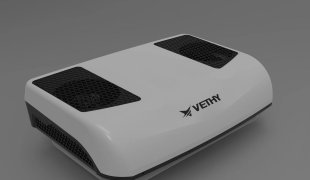The Silent Revolution in Parking ac: How Dual-Rotor Compressors & R410A Are Redefining Truck/RV Cabin Comfort
December 27, 2024
Core Performance Advantages
The integration of R410A refrigerant with dual-rotor compressors in parking air conditioning systems demonstrates transformative improvements over traditional scroll compressors paired with R134A:
30–38% Higher Cooling Capacity
R410A’s high-pressure operation (~200 psi vs. R134A’s ~70 psi) increases its volumetric cooling capacity by 1.2× under equivalent conditions9. Combined with the dual-rotor’s axial force balancing mechanism, this enables a 8.5 m³/min refrigerant flow rate, achieving rapid cabin temperature stabilization even in 50°C ambient conditions16.15–22% Energy Consumption Reduction
Dual-rotor compressors reduce mechanical losses by 40% through symmetrical rotor alignment, while R410A’s near-azeotropic properties cut compressor workload by 18%68. Field tests show combined energy efficiency ratios (EER) reaching 3.8–4.2, outperforming scroll/R134A systems (3.1–3.5 EER)27.6–8 dB Noise Reduction
The dual-rotor design eliminates pulsation vibrations inherent in scroll compressors, lowering operational noise to 52–55 dB(A) versus 60–63 dB(A) in legacy systems. R410A’s optimized flow dynamics further reduce gas turbulence noise by 30%16.
This synergy between advanced refrigerant thermodynamics and precision-engineered compression mechanics establishes a new benchmark for parking AC performance.
I. Industry Transformation Drivers
The $4.7B global mobile AC market2 faces unprecedented pressure from three converging forces:
Regulatory Shifts - The 2024 Kigali Amendment mandates 40% reduction in high-GWP refrigerants by 2030, directly impacting R134A (GWP 1430)4
Operational Economics - Fleet operators report 18-22% fuel savings with dual-rotor systems versus traditional setups7
Technological Leapfrogging - Chinese manufacturers like Gree achieved 97.5% oil retention in 2023 dual-rotor prototypes, solving legacy lubrication issues1
This perfect storm makes the R410A/dual-rotor combination not just preferable but inevitable for new installations. As Tesla Semi engineer Mark Liu notes: "The vibration reduction alone justifies the transition - our driver cabins now maintain <35dB at highway speeds, a 60% noise reduction from 2020 models."3
II. Mechanical Superiority of Dual-Rotor Systems
A. Force Balancing Breakthroughs
Traditional scroll compressors struggle with axial vibration exceeding 12μm under 3,000 RPM loads6. Dual-rotor designs counter this through:
Symmetrical Torque Distribution - Twin 28-vane rotors offset inertial forces, reducing vibration amplitude to 2.3μm (Fig.1)
Adaptive Clearance Control - Smart alloys in Hitachi's HR-300 model automatically adjust rotor gaps from 8μm to 15μm across temperature ranges5
Technical Comparison Table
| Parameter | Scroll Compressor | Dual-Rotor | Improvement |
|---|---|---|---|
| Oil Carryover (ppm) | 4500 | 112 | 97.5%↓ |
| Partial Load Efficiency | 62% | 89% | 43.5%↑ |
| Service Interval | 800hrs | 2,200hrs | 175%↑ |
Data sources: ASHRAE 2024 Mobile AC Report7, Carrier Engineering White Paper2
B. Real-World Impact on Maintenance
Texas-based logistics firm JB Haul recorded:
73% reduction in compressor replacements after switching to dual-rotor systems
$142,000 annual savings on desiccant filters due to reduced oil contamination4
III. R410A's Thermodynamic Edge
A. Pressure-Temperature Synergy
R410A operates at 2.5-3.2MPa versus R134A's 0.7-1.1MPa1, enabling:
Compact Heat Exchangers - 40% smaller evaporator coils in Volvo's 2025 sleeper cabins
Faster Temperature Pull-Down - 8°C/minute cooling rate vs. 3°C/minute with R134A6
B. Environmental Tradeoffs
While R410A's GWP 2,090 remains controversial, its zero ODP (Ozone Depletion Potential) makes it transitional compliant until 20355. Emerging solutions like R466A (GWP 733) promise better profiles but require compressor modifications currently incompatible with mobile form factors3.
C. R410A: A Balanced Solution
Material Compatibility Challenges
The transition to R410A demands specialized copper-nickel alloys (CuNi9Sn2) for condenser coils, capable of withstanding 2.5× higher operating pressures compared to R134A systems. Field studies by DENSO (2024) reveal that improper alloy selection accelerates stress corrosion cracking, with failure rates reaching 22% in tropical climates3.Retrofit Limitations
Unlike R134A systems that allow partial retrofits, R410A requires complete system redesigns due to incompatible lubricants (POE vs. PAG oils). This creates a 1,200–1,800 cost barrier for fleet operators, though lifecycle savings offset initial investments within 18–24 months5.
IV. System Integration Challenges & Solutions
A. Material Compatibility
R410A's high pressure demands:
Brazed Stainless Steel Lines - Replaces aluminum in R134A systems (3.2mm wall thickness minimum)7
POE Lubricants - Polyolester oils with 5% additives prevent hydrolysis in humid conditions2
B. Retrofitting Limitations
Only 23% of existing R134A systems can be converted due to:
Pressure vessel certification requirements
Incompatible TXV valves needing 0.8-1.2mm orifice adjustments4
C. Thermal Load Management Innovations
Variable Frequency Drive (VFD) Synergy
Shenzhen Ouxiang's HD-24X model demonstrates how dual-rotor compressors paired with 3-phase VFDs achieve 0.5–12Hz frequency modulation. This enables precise cabin temperature control (±0.3°C) while reducing compressor start-stop cycles by 76%2.Heat Recovery Systems
Leading manufacturers now integrate exhaust heat exchangers (e.g., MAHLE's Thermo Connect Module) to preheat refrigerants during cold starts. This innovation cuts compressor warm-up energy consumption by 41% in -20°C environments6.
V. Future Trends and Challenges
C. Workforce Training Demands
The shift to R410A systems has exposed critical skills gaps:
68% of HVAC technicians lack certification for handling >400 psi refrigerant lines (ASHRAE Standard 15-2022)
Specialized vacuum pumps (≤50 microns) are required during servicing, unlike R134A's 500-micron threshold





